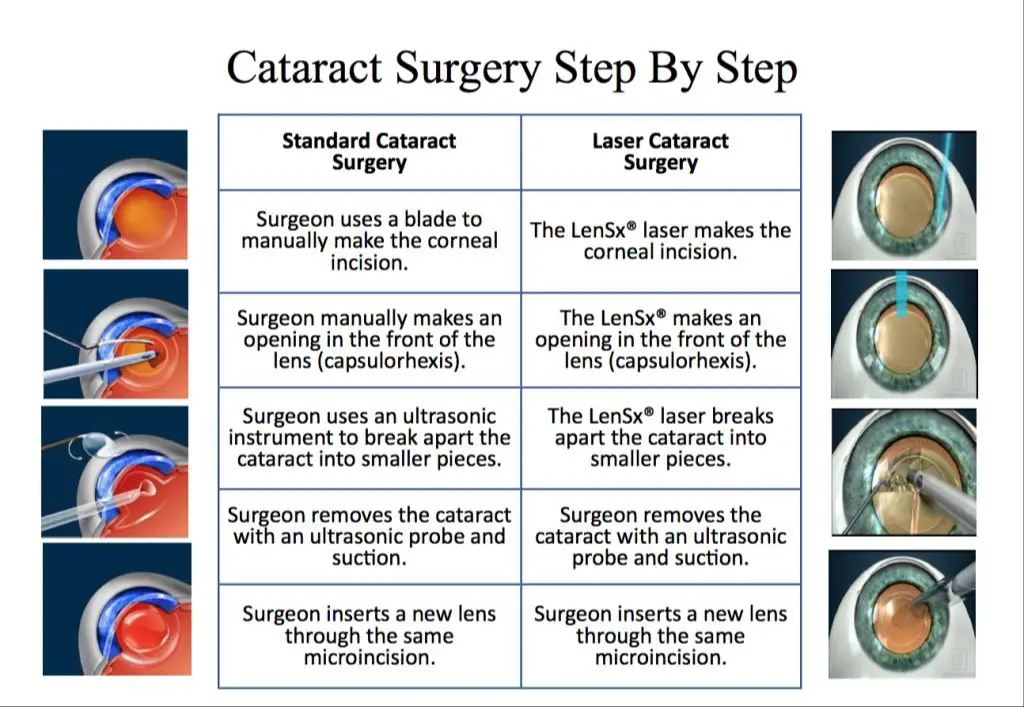Introduction to Medicare Coverage for Cataract Surgery
Medicare is the federal health insurance program for people aged 65 or older. It also covers some younger people with disabilities. Medicare Part A covers hospital stays, and Medicare Part B covers doctor visits and outpatient services. Cataract surgery is considered medically necessary and is covered under Medicare Part B.
Cataract surgery involves removing the eye’s cloudy natural lens and replacing it with an artificial lens called an intraocular lens (IOL). The most common type of cataract surgery is called phacoemulsification. This traditional method uses an ultrasonic probe to break up the cloudy lens, which is then suctioned out. The surgeon then inserts an IOL through a small incision.
A newer type of cataract surgery uses a laser, rather than a physical surgical tool, to make the incisions and soften or break up the lens. This is known as laser cataract surgery or femtosecond laser-assisted cataract surgery. Medicare covers both traditional and laser cataract surgery.

What is a Cataract and Cataract Surgery?
A cataract is a clouding of the natural lens in the eye that affects vision. As we age, the lens can become less transparent and cloudy, causing blurred vision, faded colors, halos around lights, trouble seeing at night, and sensitivity to glare.
Symptoms of cataracts typically include:
- Blurry vision
- Seeing double or multiple images
- Frequent changes in eyeglass prescription
- Glare or halos around lights
- Trouble seeing at night
- Faded color vision
Cataract surgery is performed when the cataract has progressed enough to impair important daily activities like reading, driving, watching TV, and recognizing faces. During cataract surgery, the cloudy natural lens is removed and replaced with a clear artificial lens implant to restore vision.
Cataract surgery is one of the most common and successful procedures performed today. It is minimally invasive and usually takes less than 30 minutes. The surgeon makes a tiny incision in the eye and uses ultrasound waves to break up the cloudy lens, which is then suctioned out. The new artificial lens is inserted in place of the natural lens.
Types of Cataract Surgery
There are two main types of cataract surgery – traditional/manual surgery and laser-assisted surgery:
Traditional cataract surgery, also known as phacoemulsification, involves the surgeon making a small incision in the eye and using handheld surgical instruments to break up and remove the cloudy lens. The natural lens is then replaced with a clear artificial intraocular lens implant. This is the standard method that has been used for decades and is proven to be generally safe and effective.
Laser cataract surgery is a newer technology that uses a femtosecond laser to assist in parts of the procedure. First, the laser is used to create more precise incisions in the cornea and lens capsule. Next, the laser softens and breaks up the cataract, allowing the surgeon to then remove the pieces with less ultrasound energy. This is followed by placement of the artificial lens as normal. The laser provides computer-guided precision at certain steps compared to the traditional manual approach.[1]
Potential benefits of laser cataract surgery can include more accurate incisions, less ultrasound energy needed, better centering and positioning of the implant lens, and faster visual recovery for patients. However, traditional surgery remains highly effective and safe in the hands of an experienced surgeon.
Medicare Coverage for Cataract Surgery

Medicare Part B covers a portion of the costs for cataract surgery performed in a doctor’s office or ASC (Ambulatory Surgical Center). This includes the surgeon fees, facility fees, anesthesia, and basic intraocular lens implants. Patients are responsible for 20% of the Medicare-approved amount after meeting their Part B deductible, which is $226 in 2023.
Medigap supplemental insurance can help cover the out-of-pocket costs like coinsurance and deductibles. Medicare Advantage plans may also provide additional coverage but there can be more prior authorization requirements. According to Medicare.gov [1], some Medicare Advantage plans offer extra benefits for cataract surgery like coverage for premium IOLs.
So while original Medicare covers a portion of cataract surgery, supplemental insurance can reduce a patient’s out-of-pocket expenses. Patients should review their Medicare Advantage or Medigap policy for specifics on copays, deductibles, and extra coverage for premium IOL options.
Medicare Reimbursement Rates for Cataract Surgery
Medicare determines reimbursement rates for cataract surgery procedures using a fee schedule that sets payment amounts for different services. The Procedure Price Lookup tool from Medicare provides the national average costs for cataract surgery procedures in different settings.
For traditional cataract surgery (CPT code 66984), the national average Medicare reimbursement is around $748 in an ambulatory surgical center and $1365 in a hospital outpatient setting. For complex cataract surgeries (CPT code 66982), reimbursement averages around $979 in an ASC and $1596 in a hospital. The professional fee for the surgeon averages around $628 for traditional cataract surgery.
In general, Medicare reimbursement rates for cataract surgery have fallen over time but still cover a portion of the overall procedure costs. Patients are responsible for deductibles and coinsurance, which can add several hundred dollars in out-of-pocket costs.
Reimbursement Differences Between Laser and Traditional Surgery
There are significant differences in how much Medicare reimburses for traditional cataract surgery versus laser cataract surgery. According to CMS guidelines, Medicare Part B covers cataract removal and insertion of a standard monofocal IOL regardless of the technique used during surgery. However, Medicare does not cover the additional cost of femtosecond laser-assisted cataract surgery.

For traditional cataract surgery, the 2022 Medicare physician fee schedule reimbursement rate is approximately $750 for the surgery and standard lens. If advanced technology IOLs are used, there are additional reimbursements of around $50 for toric lenses that correct astigmatism and up to $350 for presbyopia-correcting lenses.
In comparison, the total out-of-pocket cost for laser cataract surgery can range from $500-$1500 more than traditional surgery. This includes the surgeon’s fee for the laser as well as the additional facility fee which covers purchase and maintenance of the femtosecond laser equipment. Medicare considers use of the laser to be an elective, non-covered upgrade similar to advanced IOLs.
The main reasons for lower reimbursement rates for laser cataract surgery are:
- Lack of definitive clinical evidence showing superior visual outcomes compared to traditional phacoemulsification cataract surgery.
- High cost of femtosecond laser equipment for ophthalmology practices and surgery centers.
- Considered an elective add-on service that does not change Medicare’s coverage of the cataract procedure itself.
Overall, while laser cataract surgery is widely available, the additional out-of-pocket costs mean that traditional surgery remains the standard of care covered by Medicare. Patients should consult with their surgeon to determine if the benefits of laser-assisted surgery outweigh the extra fees.
Patient Out-of-Pocket Costs
Although Medicare covers a significant portion of cataract surgery costs, patients will still be responsible for certain out-of-pocket expenses. This includes Medicare deductibles and coinsurance.
The standard Medicare Part B deductible must be paid by the patient before Medicare coverage begins. In 2023, the Part B deductible is $226. The Part B deductible applies once per year, so if you’ve already paid it for other medical services, it does not apply again for cataract surgery.
In addition to the Part B deductible, patients must pay 20% of the Medicare-approved amount for the surgeon’s services. For traditional cataract surgery, the average coinsurance amount is around $500-600 per eye. For laser cataract surgery, the coinsurance amount is typically $800-1,000 per eye due to the higher overall cost.
Besides coinsurance for the surgeon, patients may incur additional out-of-pocket costs for the facility fees. Many patients have supplemental insurance plans like Medigap that cover Part B coinsurance costs. Without supplemental coverage, total out-of-pocket costs for cataract surgery commonly range from $700-1,200 per eye for traditional surgery and $1,000-1,400 per eye for laser surgery.
Ways for Patients to Save on Cataract Surgery
Even with Medicare coverage, cataract surgery can still cost patients hundreds or thousands of dollars out-of-pocket. However, there are ways patients can reduce their costs for this common procedure.

One of the best ways to save on cataract surgery is to use in-network providers. Medicare has contracted rates with in-network doctors and facilities which are significantly lower than what out-of-network providers may charge. Going out-of-network means patients will be responsible for paying the difference between what Medicare covers and the provider’s full charges.
Purchasing supplemental Medigap or Medicare Advantage insurance plans can also offset out-of-pocket expenses. These plans cover Medicare deductibles, copays and coinsurance costs. Patients with supplemental coverage pay an average of $139 out-of-pocket for cataract surgery compared to $1,322 for those with only Original Medicare.
Some surgeons and facilities offer cataract surgery coupons or discounts for uninsured patients. Providers may also negotiate costs or offer payment plans to reduce the financial burden. Checking with local providers about available discounts can help patients save hundreds or even thousands of dollars on their procedure.
Taking advantage of these savings opportunities allows patients to access quality cataract surgery care while minimizing out-of-pocket expenses.
Finding the Right Surgeon and Facility
Choosing the right cataract surgeon and ambulatory surgery center is crucial for a safe and successful procedure. Here are some tips for selecting a skilled surgeon and facility:
Tips for choosing a skilled cataract surgeon:
- Look for a board-certified ophthalmologist who specializes in cataract surgery and has years of experience performing the procedure.
- Ask about the number of cataract surgeries the doctor performs annually – a high volume indicates greater experience and skill.
- Inquire about complication rates – an experienced surgeon should have a very low rate of complications.
- Consider patient reviews and testimonials to evaluate surgical skill and bedside manner.
- Make sure the surgeon uses the latest technology and techniques.
Questions to ask about experience and results:
- How many cataract surgeries do you perform each year?
- What is your rate of complications?
- What techniques and technology do you use?
- Do you have before and after photos I can see?
- What results do your patients typically achieve?
- May I speak to some of your former patients?
How to select an ambulatory surgery center:
- Choose an accredited facility that specializes in ophthalmic procedures.
- Confirm the surgery center has the proper equipment for cataract surgery.
- Ask about support staff training and experience with cataract procedures.
- Evaluate patient satisfaction scores and complication rates.
- Consider the center’s reputation and recommendations from eye doctors.
- Tour the facility to check cleanliness, staff professionalism and bedside manner.
Taking the time to carefully select your surgeon and facility can help ensure you have the best possible cataract surgery experience and outcome.
Deciding Between Laser and Traditional Cataract Surgery
When it comes to cataract surgery, patients have a choice between traditional cataract surgery and laser-assisted cataract surgery. Both procedures aim to remove the cloudy natural lens and replace it with an artificial intraocular lens to restore clear vision. However, there are some differences in the techniques used.
In traditional cataract surgery, the surgeon makes incisions in the eye with surgical blades and breaks up the cloudy lens using ultrasound waves. The fragments are then suctioned out and the new artificial lens inserted. With laser cataract surgery, the initial incisions are made with a precise laser rather than a blade. The laser also softens the lens which requires less ultrasound energy to break it up.
According to https://moscowfamilyeye.com/is-laser-assisted-cataract-surgery-better-than-traditional-cataract-surgery/, potential benefits of laser cataract surgery include more accurate incisions, less inflammation, and faster healing. However, traditional surgery also has a proven track record of safety and success.
When deciding between laser vs traditional surgery, the most important factor is choosing an experienced cataract surgeon you trust. Patient preference is also key – some may value the high-tech approach of laser, while others may opt for the tried and true traditional method.
The best approach is to consult with your eye doctor and surgeon. They can help determine if you are a good candidate for laser cataract surgery based on the type and severity of your cataracts. Be sure to discuss the pros and cons of each method for your individual case.

